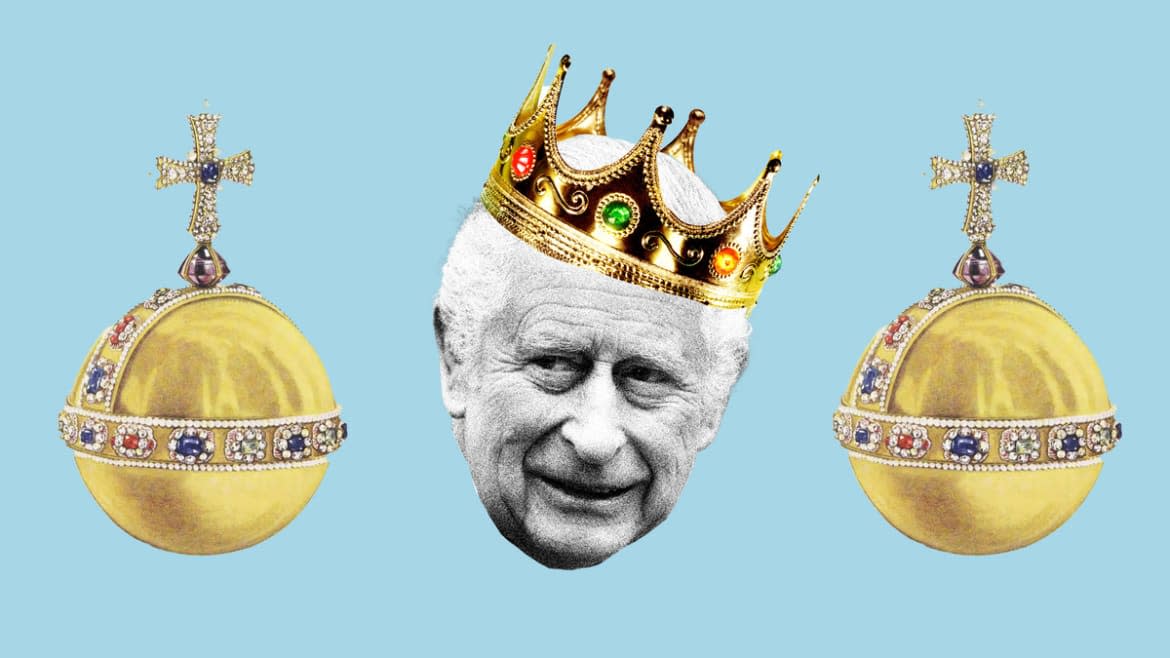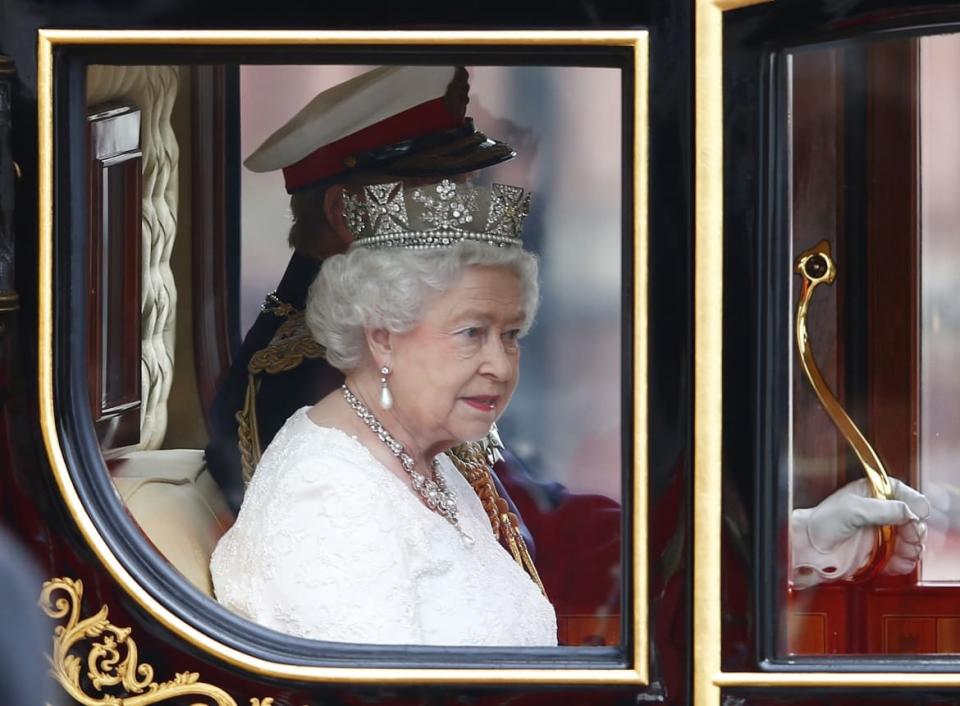Inside King Charles’ Coronation of Crazy Rituals, Jewels, and Orbs

- Oops!Something went wrong.Please try again later.
- Oops!Something went wrong.Please try again later.
- Oops!Something went wrong.Please try again later.
- Oops!Something went wrong.Please try again later.
- Oops!Something went wrong.Please try again later.
Royalist is The Daily Beast’s newsletter for all things royal and Royal Family. Subscribe here to get it in your inbox every Sunday.
On Saturday May 6, King Charles will become the 40th monarch to be formally crowned King or Queen of England at Westminster Abbey. William the Conqueror inaugurated the venerable tradition on Christmas Day of 1066. Three monarchs missed out on their big day—the boy king Edward V, murdered by his Uncle Richard in the Tower, and that rotter/ great romantic hero Edward VIII who eloped with Wallis Simpson in 1936 before the necessary arrangements could be made.
Lady Jane Grey had a better excuse for skipping a date at the Abbey, given that she managed to hang onto the crown for only nine days before getting deposed (and executed, natch).
American viewers will be able to watch proceedings on all the major networks, kicking off from 5 a.m. Eastern Time. Streaming platforms FuboTV, Sling TV, Hulu and DirecTV will all have it available on their services as well.
Don’t Blink, or You May Miss Prince Harry at King Charles’ Coronation
The incredible tradition of English coronations means that if William the Conqueror were to tune in, he would completely get what was going on while the spirits of any kings crowned after about A.D. 1300 would probably feel right at home, and indeed, recognize many of the accoutrements being used.
The coronation chair, for example, was built by Edward I in 1300 and encloses the Stone of Destiny (known to the Scots, from whom it was captured as the Stone of Scone) and has been a feature of every coronation since 1306.
Then of course we come to the crown jewels, which will be presented to Charles on the day to represent various kingly graces and attributes. They include golden spurs (representing knighthood and chivalry), the jeweled Sword of Offering (1820) and the armills (gold bracelets representing sincerity and wisdom, made in 1953 for Queen Elizabeth II). The Sovereign’s Orb (representing Christian sovereignty, 1661) is placed in his right hand, as is the coronation ring (representing kingly dignity, 1831).
Two scepters are also presented; the Scepter with Cross, ironically, symbolizes temporal power and the “divine right” of kings to rule, while the Scepter with Dove—aka the Rod of Equity and Mercy, represents the spiritual side of being king.
The “regalia” have been through various iterations in their 1,000-year history. Much of the current set claims to date from the coronation of Charles II (1661), which marked the restoration of the monarchy after the overthrow of Cromwell who, unsurprisingly, had the crown jewels melted down and sold, being symbols of the “detestable rule of kings” as they were.
Charles II spent £12,185 on the replacement set. However, in lean periods or wartime, jewels were sometimes pawned or sold to replenish the coffers, and several coronations from the reign of Anne (1702) to Victoria (1838) were undertaken with—gasp!—hired jewels set in the various crowns for the day.
Wildly anachronistic costumes will of course be much in evidence. King Charles will wear no fewer than four different outfits in the two-hour Coronation ceremony, beginning with military uniform topped by the crimson robe of state. For the anointing with holy oil he wears just a white shirt.

Britain’s Queen Elizabeth II, accompanied by Prince Philip, in the new Diamond Jubilee State Coach, in central London, June 4, 2014.
After that, it's into the “Colobium Sindonis”—a linen tunic symbolizing purity—and the quick change show will culminate in Charles sporting a long, flowing robe called a “Robe Royal” or “Imperial Mantle,” made of silk velvet and lined with ermine. This robe was made in 1821 for the coronation of George IV. This goes over the fabulously named “supertunica,” a gold coat that dates back to the coronation of George V in 1911. An intricate coronation glove, dating from 1937, symbolizing power, will be placed on his right hand as part of the ceremony.
Less exciting news in terms of the congregation’s attire: the few peers of the realm who have been invited have been instructed not to wear their coronation robes—family heirlooms made of fur and silk worn only at coronations—and instead wear lounge suits. The horror was expressed by one hereditary peer who was quoted as saying: “I’m very sorry about the decision that has been made. Our robes go back to the 19th century and I would have been the fifth generation to wear them. It’s very sad.”
Senior peers involved in ceremonial roles in the service will still be allowed to wear their coronation robes of crimson velvet, trimmed and lined with white ermine.
Depressingly, for lovers of royal bling, rumors are circulating that senior female members of the family won’t be wearing tiaras, instead sporting flowers in their hair. The London Times reported this week: “The decision to go for the floral look would be fully in keeping with a coronation that reflects King Charles’ belief in the importance of sustainability and his love of nature.” More evidence of Charles' slimmed-down coronation.
Transport arrangements are still emphatically opulent. Charles and Camilla will travel from Buckingham Palace to the Abbey in the 2014 Diamond Jubilee State Coach, which is the last word in regal coach travel, coming complete with air conditioning (although no goblet holders.) A modest entourage of 200 soldiers will accompany the couple on their journey.
The way home is the real blockbuster though, with the now confirmed king and queen returning to the palace escorted by 4,000 members of the armed forces, before a balcony appearance featuring “working” members of the royal family, and definitely not including Prince Andrew (although he will be at church) or Prince Harry (who might even be on a private jet home by then).
Prince Harry’s attendance, and his wife’s absence, has of course been the big story in recent weeks, overshadowing the 2000-odd other attendees, who are largely being invited if they are involved in charity or community projects associated with the king or queen. The most recognizable face to American viewers will likely be Lionel Richie, who has been involved with Charles’ Prince’s Trust charity for decades, and is playing at a special coronation concert the following evening.
Very few members of the grand old hereditary families have been invited, much to the consternation of some.
The Duke of Rutland is one of the few to have spoken out, telling the Daily Mail: “I have not been asked… But it has been families like mine that have supported the Royal Family for over 1,000 years.”
Quite, as the ghost of William the Conqueror might opine.
Get the Daily Beast's biggest scoops and scandals delivered right to your inbox. Sign up now.
Stay informed and gain unlimited access to the Daily Beast's unmatched reporting. Subscribe now.

